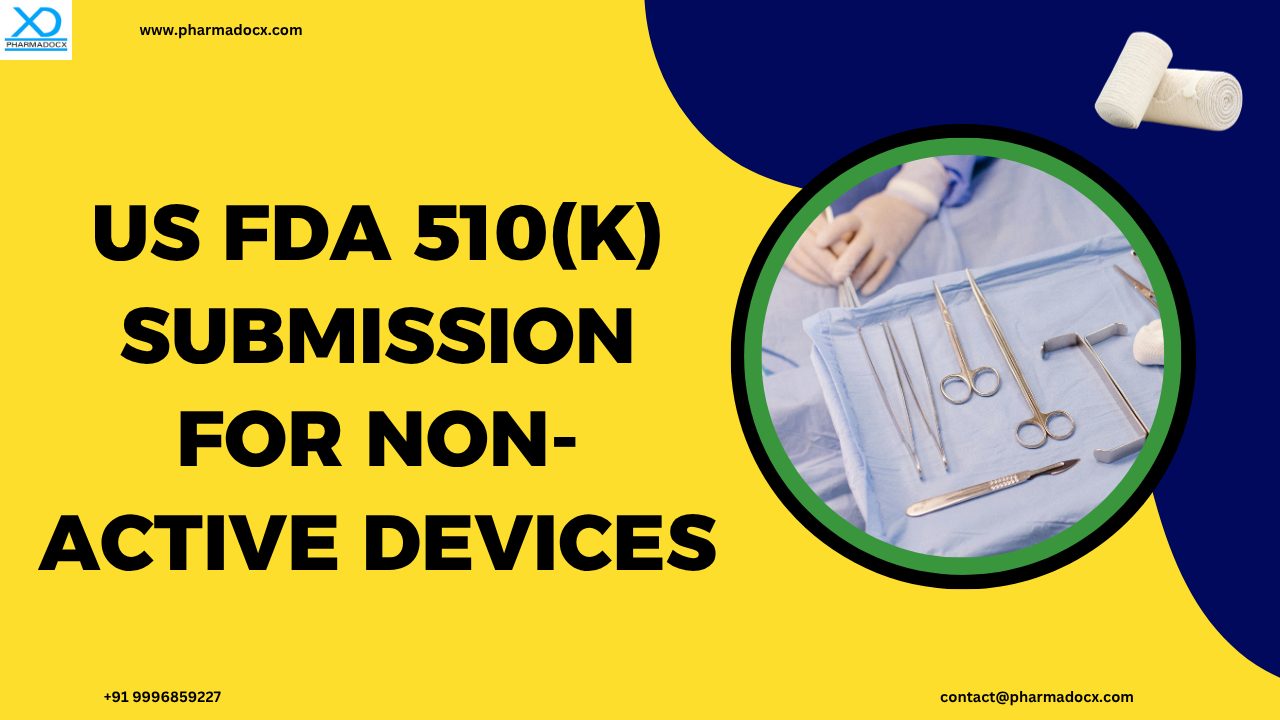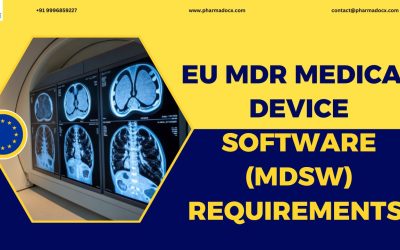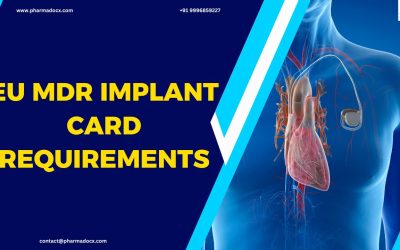Non-active devices form the backbone of clinical practice. They are often simple in design but require rigorous validation to ensure safety, especially when used invasively or for long-term. For non-active medical devices, the 510(k) submission process is rigorous but tailored to their lower risk profile. We have prepared this blog to guide you through the process of 510(k) submission for non-active devices.
What are non-active devices?
Non-active devices are those medical devices that do not rely on any external energy source, such as electricity, batteries, or gas pressure, to function. Instead, they operate through manual, gravitational, or passive means. They often rely on the body’s own mechanics or environmental conditions.
Examples of non-active devices
- General surgical tools: Scalpels, forceps, retractors
- Wound care: Bandages, gauze, sutures, surgical gloves
- Orthopedic implants: Bone plates, screws, joint spacers
- Dental devices: Manual dental instruments, crowns, bridges
- Infusion and injection: Syringes, IV cannulas, blood bags
- Ophthalmic devices: Manual lens inserters, eye speculums
- Sterilization and cleaning: Manual brushes, trays, disinfectant containers
Regulatory implications of non-active devices
Even though non-active medical devices may seem simpler than their powered counterparts, their regulation is absolutely essential. Regulation is necessary to ensure safety, efficacy, and consistency across healthcare systems.
- Risk Classification: Depending on invasiveness and duration of contact, non-active devices are classified as Class I (bandages, gloves) or II (surgical sutures, implants)
- Testing Focus: Biocompatibility, mechanical integrity, sterility (if applicable), and labelling are the focus of regulatory tests carried out.
- Documentation: Technical file includes material specifications, performance data, and clinical evidence (if needed).
6 Key characteristics of non-active medical devices
- No external energy source: Non-active medical devices operate without electricity, batteries, or gas pressure. They function based on manual action, gravity, or passive mechanisms.
- Material-driven functionality: Performance depends heavily on material composition, mechanical properties, and surface characteristics. It requires rigorous biocompatibility testing per ISO 10993. Material safety data sheets (MSDS) are critical for regulatory filings.
- Sterility (if applicable): Many non-active devices are invasive or used in sterile fields. Hence, sterilization validation (e.g., EO, gamma, steam) is essential for these Class II devices. Moreover, labeling must reflect sterility status and shelf life.
- Mechanical performance: Mechanical performance depends on dimensional accuracy, tensile strength, durability, and fatigue resistance ability. Bench testing is often sufficient to demonstrate performance.
- Simple or no electronics: No sensors, software, or powered components. These devices are easy to validate but still subject to design controls under FDA regulations and ISO 13485.
- Predicate reliance in 510(k): 510(k) submission for non-active devices relies on demonstration of substantial equivalence with predicate device. Substantial equivalence is often based on design, materials, and intended use. Comparative tables are key to demonstrating similarity between proposed device and predicate device.
Need for regulating non-active devices
Non-active devices are subjected to regulatory oversight to ensure they are safe, effective, and of highest quality. Hence, 510(k) submission for non-active devices intended for US market is mandatory. We have highlighted the reasons why non-active devices have to be regulated.
- Patient safety: Non-active devices often come into direct contact with the body, such as skin, mucosa, or internal tissues. The risks include infection, toxicity, mechanical failure, or adverse reactions from materials. Regulation focus is necessary on biocompatibility, sterility, and mechanical integrity.
- Quality assurance: Without oversight, manufacturers may use substandard materials or skip critical validation steps. Regulatory frameworks enforce design controls, process validation, and post-market surveillance.
- Global harmonization: With increasing cross-border trade, consistent regulatory standards help avoid duplication of testing, enable faster market access, and support mutual recognition agreements (MRAs).
- Market surveillance and recalls: Regulation enables tracking of adverse events, field safety notices, and recall procedures. It ensures accountability and continuous improvement.
- Ethical and legal compliance: Regulation for non-active devices protects patients from unproven claims, misleading labeling, and unsafe practices. It builds trust in healthcare systems and manufacturers.
US FDA 510(k) submission for non-active devices: Step-by-step process
- Device classification and regulatory pathway: Identify the FDA product code and device classification (Class I or II). Confirm whether the device requires a Traditional, Abbreviated, or Special 510(k).
- Device characterization and predicate identification: Define the clinical purpose and intended use of the device. Clarify how the device will be used in practice. In the detailed device description, mention the physical characteristics, materials, sizes, accessories, and mode of action. Additionally, provide diagrams, images, and a summary of performance testing (bench tests).Identify a legally marketed device with similar intended use and technological characteristics. This device will act as the predicate. Use FDA’s 510(k) database to find a suitable predicate. Build a substantial equivalence rationale. This a vital step in US FDA 510(k) submission for non-active devices.
- Supporting documentation: Device drawings should include labeled schematics with components and dimensions. Material safety data sheets (MSDS) are especially important for devices with patient contact. The manufacturing process flowchart should outline each step, from raw material to final packaging. Biocompatibility data should be provided if the device contacts skin, mucosa, or internal tissues. Notably, even for non-active devices, sterility assurance is critical for invasive products.
- Testing and validation: Bench testing focuses on mechanical strength, durability, dimensional accuracy. Biocompatibility tests asses body-contacting materials. Sterilization validation will be required for invasive or surgical devices. Shelf-life and packaging integrity tests are vital for non-active devices, especially for sterile products.
- eSTAR preparation: FDA now mandates use of eSTAR for most 510(k) submissions. Hence, the application has to be prepared accordingly. Structured format improves review efficiency and reduces errors. Moreover, include all attachments in FDA-preferred formats (PDF, labeled sections).
- Submission and FDA review: Submit your 510(k) submission for non-active devices electronically. FDA will conduct administrative review (15 days) and substantive review (up to 90 days). Respond to additional information (AI) requests promptly.
- Clearance and post-market obligations: Upon clearance, you will receive an US FDA 510(k) number and approval letter. Maintain design history file, have a complaint handling plan in place, and conduct post-market surveillance. Prepare for FDA inspections and be ready for recall, if required.
7 Pro tips for smooth 510(k) submission
We have provided some pro tips for 510(k) submission for non-active devices.
- Choose the appropriate predicate: Correct predicate device selection is a vital step. Choose a predicate with matching intended use and technological characteristics. Use FDA’s Product Classification database and 510(k) Premarket Notification database. Build a comparison matrix showing substantial equivalence in design, materials, and performance.
- Use eSTAR for application submission: FDA’s eSTAR template is now mandatory for most 510(k) submissions. It enforces structure, reduces errors, and improves review efficiency. Prepare all content in advance to avoid last-minute formatting issues.
- Biocompatibility tests: Even simple non-active devices need ISO 10993 testing if they contact the body. Include test reports, rationale for test selection, and cytotoxicity, sensitization, irritation data. Reference FDA’s biocompatibility guidance for clarity.
- Sterilization validation (if applicable): For invasive or surgical devices, include sterilization method (e.g., EO, gamma, steam) and sterility assurance level documentation. Moreover, packaging integrity and shelf-life testing are important requirements.
- Labeling must match claims: Ensure all claims in IFUs, packaging, and marketing materials are supported by testing. Avoid vague or exaggerated language. Include clear instructions for use, warnings, and contraindications.
- Build a robust device description: The device description should include materials, dimensions, accessories, and variants as well as mode of action and mechanical principles. It should include diagrams and annotated photos. A robust device description will go a long way in a successful 510(k) submission for non-active devices.
- Create a submission checklist: Track every component: forms, summaries, testing, labeling, predicate comparison. Use version control and internal review cycles to identify gaps in the application. Consider a pre-submission meeting, if your device has novel features.
Email at [email protected] or call/Whatsapp on 9996859227 for a hassle-free for 510(k) submission for non-active devices.





